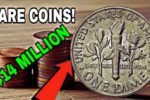Hidden Gems in Your Pocket Change
The U.S. State Quarters, minted from 1999 to 2008, are more than just cool designs celebrating each state—they’re a goldmine for collectors. Some quarters with rare minting mistakes are worth over $1,000, turning everyday change into treasure. A recent find in Ohio, reported on May 29, 2025, saw a 2004 Wisconsin quarter with an error fetch $2,500 at auction. These mistakes, from doubled images to missing layers, have collectors buzzing. Here’s a look at six state quarter errors that could make you rich.
Why Errors Make Quarters Valuable
Minting errors happen when something goes wrong during coin production, like a misaligned strike or a damaged die. These mistakes are rare, making the coins super valuable to collectors. The State Quarters program, with its unique designs for all 50 states, produced some standout errors that grab attention. High-grade coins, especially those graded MS65 or higher, can sell for thousands due to their rarity and condition. Checking your change for these flaws could lead to a big payday.
Top Six State Quarter Errors
These six state quarter errors are some of the most sought-after, each worth $1,000 or more:
| State Quarter Error | Estimated Value | Why It’s Valuable |
|---|---|---|
| 1999 Delaware Spitting Horse | $1,500-$2,000 | Die crack makes horse appear to spit |
| 2004-D Wisconsin Extra Leaf | $1,500-$6,000 | Extra leaf on corn stalk, high or low |
| 1999 Georgia Experimental Planchet | $2,000-$10,000 | Struck on gold-colored Sacagawea alloy |
| 2000-P South Carolina Mule | $35,000 | Struck on Sacagawea dollar planchet |
| 1999 Connecticut Broadstrike | $1,500-$3,000 | Coin stretched, design distorted |
| 2009-D DC Doubled Die | $1,000-$4,000 | Doubled text on Duke Ellington design |
These errors are rare, but they’ve been found in circulation, making every quarter worth a closer look.
How to Spot These Rare Coins
Finding a valuable error quarter takes a keen eye. Use a magnifying glass to check for flaws like the “spitting horse” on Delaware quarters, where a line extends from the horse’s mouth, or the extra leaf on Wisconsin quarters near the corn stalk. Look for coins with odd colors, like the golden 1999 Georgia quarter, or misaligned designs, like the Connecticut broadstrike. Weighing coins can help spot planchet errors, as they may differ from the standard 5.67 grams. If you think you’ve got a winner, get it graded by a professional service like PCGS or NGC to confirm its value.
The Thrill of the Hunt
The Ohio find has collectors rushing to check their quarters, with auction houses reporting more error coins hitting the market. The 2000-P South Carolina mule, struck on a Sacagawea dollar planchet, is the priciest, selling for $35,000 in 2013. Even less dramatic errors, like the Wisconsin extra leaf, can fetch up to $6,000 in top condition. Collectors love these coins for their quirks and historical value, especially early releases like the 1999 Delaware quarter. The hunt is on, as more errors could still be hiding in pocket change or old collections.
Tips for Collectors and Next Steps
If you want to join the treasure hunt, start by checking quarters from 1999 to 2009. Look for unusual details like doubled text, extra design elements, or missing layers. Don’t clean coins, as this can lower their value. Coin shops, auctions, or online platforms like eBay are great places to sell valuable finds, but grading is key for high-value errors. With some luck and a sharp eye, you could uncover a quarter worth thousands. So, grab a magnifying glass and start searching your next handful of change might hold a collector’s dream.




